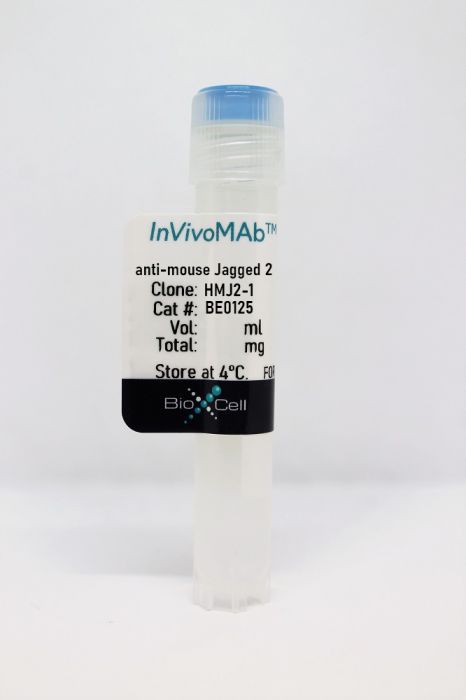InVivoMAb anti-mouse Jagged 2
Product Details
The HMJ2-1 monoclonal antibody reacts with mouse Jagged 2 one of many Notch ligands. Jagged 2 is expressed by thymic lymphoid and stromal cells, as well as macrophages and dendritic cells in the spleen. The Notch pathway is an important intercellular signaling pathway that plays a major role in controlling cell fate. The HMJ2-1 antibody has been shown to neutralize Jagged 2 in vivo.Specifications
| Isotype | Armenian hamster IgG |
|---|---|
| Recommended Isotype Control(s) | InVivoMAb polyclonal Armenian hamster IgG |
| Recommended Dilution Buffer | InVivoPure pH 7.0 Dilution Buffer |
| Conjugation | This product is unconjugated. Conjugation is available via our Antibody Conjugation Services. |
| Immunogen | CHO cells expressing mouse Jagged-2 |
| Reported Applications | in vivo Jagged 2 neutralization |
| Formulation |
PBS, pH 7.0 Contains no stabilizers or preservatives |
| Endotoxin |
<2EU/mg (<0.002EU/μg) Determined by LAL gel clotting assay |
| Purity |
>95% Determined by SDS-PAGE |
| Sterility | 0.2 µm filtration |
| Production | Purified from cell culture supernatant in an animal-free facility |
| Purification | Protein A |
| RRID | AB_10949305 |
| Molecular Weight | 150 kDa |
| Storage | The antibody solution should be stored at the stock concentration at 4°C. Do not freeze. |
Recommended Products
in vivo Jagged 2 neutralization
Riella, L. V., et al. (2013). "Jagged2-signaling promotes IL-6-dependent transplant rejection" Eur J Immunol 43(6): 1449-1458. PubMed
The Notch pathway is an important intercellular signaling pathway that plays a major role in controlling cell fate. Accumulating evidence indicates that Notch and its ligands present on antigen-presenting cells might be important mediators of T helper cell differentiation. In this study, we investigated the role of Jagged2 in murine cardiac transplantation by using a signaling Jagged2 mAb (Jag2) that activates recombinant signal-binding protein-Jkappa. While administration of Jag2 mAb had little effect on graft survival in the fully allogeneic mismatched model BALB/c–>B6, it hastened rejection in CD28-deficient recipients. Similarly, Jag2 precipitated rejection in the bm12–>B6 model. In this MHC class II-mismatched model, allografts spontaneously survive for >56 days due to the emergence of Treg cells that inhibit the expansion of alloreactive T cells. The accelerated rejection was associated with upregulation of Th2 cytokines and proinflammatory cytokine IL-6, despite expansion of Treg cells. Incubation of Treg cells with recombinant IL-6 abrogated their inhibitory effects in vitro. Furthermore, neutralization of IL-6 in vivo protected Jag2-treated recipients from rejection and Jagged2 signaling was unable to further accelerate rejection in the absence of Treg cells. Our findings therefore suggest that Jagged2 signaling can affect graft acceptance by upregulation of IL-6 and consequent resistance to Treg-cell suppression.
in vivo Jagged 2 neutralization
Elyaman, W., et al. (2012). "Notch receptors and Smad3 signaling cooperate in the induction of interleukin-9-producing T cells" Immunity 36(4): 623-634. PubMed
Interleukin 9 (IL-9) is a pleiotropic cytokine that can regulate autoimmune responses by enhancing regulatory CD4(+)FoxP3(+) T regulatory (Treg) cell survival and T helper 17 (Th17) cell proliferation. Here, we analyzed the costimulatory requirements for the induction of Th9 cells, and demonstrated that Notch pathway cooperated with TGF-beta signaling to induce IL-9. Conditional ablation of Notch1 and Notch2 receptors inhibited the development of Th9 cells. Notch1 intracellular domain (NICD1) recruited Smad3, downstream of TGF-beta cytokine signaling, and together with recombining binding protein (RBP)-Jkappa bound the Il9 promoter and induced its transactivation. In experimental autoimmune encephalomyelitis (EAE), Jagged2 ligation regulated clinical disease in an IL-9-dependent fashion. Signaling through Jagged2 expanded Treg cells and suppressed EAE when administered before antigen immunization, but worsened EAE when administered concurrently with immunization by favoring Th17 cell expansion. We propose that Notch and Smad3 cooperate to induce IL-9 and participate in regulating the immune response.
- In Vitro,
- Neutralization,
- Mus musculus (House mouse),
- Neuroscience
Reciprocal communication between astrocytes and endothelial cells is required for astrocytic glutamate transporter 1 (GLT-1) expression.
In Neurochemistry International on 1 October 2020 by Martínez-Lozada, Z. & Robinson, M. B.
PubMed
Astrocytes have diverse functions that are supported by their anatomic localization between neurons and blood vessels. One of these functions is the clearance of extracellular glutamate. Astrocytes clear glutamate using two Na+-dependent glutamate transporters, GLT-1 (also called EAAT2) and GLAST (also called EAAT1). GLT-1 expression increases during synaptogenesis and is a marker of astrocyte maturation. Over 20 years ago, several groups demonstrated that astrocytes in culture express little or no GLT-1 and that neurons induce expression. We recently demonstrated that co-culturing endothelia with mouse astrocytes also induced expression of GLT-1 and GLAST. These increases were blocked by an inhibitor of γ-secretase. This and other observations are consistent with the hypothesis that Notch signaling is required, but the ligands involved were not identified. In the present study, we used rat astrocyte cultures to further define the mechanisms by which endothelia induce expression of GLT-1 and GLAST. We found that co-cultures of astrocytes and endothelia express higher levels of GLT-1 and GLAST protein and mRNA. That endothelia activate Hes5, a transcription factor target of Notch, in astrocytes. Using recombinant Notch ligands, anti-Notch ligand neutralizing antibodies, and shRNAs, we provide evidence that both Dll1 and Dll4 contribute to endothelia-dependent regulation of GLT-1. We also provide evidence that astrocytes secrete a factor(s) that induces expression of Dll4 in endothelia and that this effect is required for Notch-dependent induction of GLT-1. Together these studies indicate that reciprocal communication between astrocytes and endothelia is required for appropriate astrocyte maturation and that endothelia likely deploy additional non-Notch signals to induce GLT-1. Copyright © 2020 Elsevier Ltd. All rights reserved.



